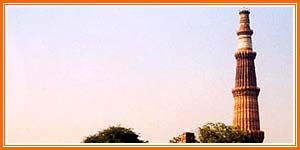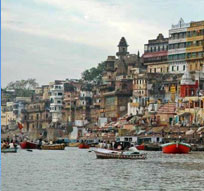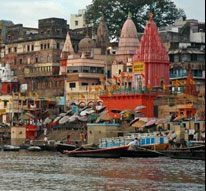The
72.55 mts. high minaretted Qutab Minar.The emblem of Delhi, the
72.55 meter high Qutab Minarwas erected in the 13th century by

Qutab-Ud-Din
Aibak. Within the complex is an Iron pillar that has never rusted.
This five storied tower is visible from several kilometers distance.
Hence, when one travels in Delhi, one truly travels through time.
Being one of the landmarks of the Walled City (Delhi, India's
capital) the city which needs no introduction, has all the
facilities as may be required by any of the foreign or domestic
tourists with any budget. It is linked with Air, Rail and Road.
Qutub
Minar is still the highest stone tower in India as well as one of
the finest Islamic structures ever raised and Delhi's recognised
landmark. The sultan's successor and son-in-law, Iltutmish,
completed it. In 1303, Ala-ud-Din established the second city of
Delhi, called Siri, of which nothing remains but the embattlements.
He also had dug a vast reservoir, Hauz Khas, to supply water to his
city. Contemporary historians describe the Delhi of that time as
being the "envy of Baghdad, the rival of Cairo and equal to
Constantinople".
For the sake of convenience,
tourists visiting the Qutub Complex could also see the Tomb of Adham
Khan and Zafar Mahal in Mehrauli and the Tomb of Jamali-Kamali
behind the Qutub Minar. These however, belong to a later date. The
Damage & Restoration From the Nagari and Persian inscriptions on
the minar, it appears that it was damaged twice by lightning, in
1326 and 1368.
The Iron Pillar In the courtyard of
the Quwwatu'l-Islam mosque stands the famous iron pillar, which
bears a Sanskrit inscription in Gupta script, palaeographically
assignable to the 4th century, a date which is also confirmed by the
peculiar style of its 'Amalaka'-capital. The inscription records
that the pillar was set up as a standard or dhvaja of god Vishnu on
the hill known as 'Vishnupada', in the memory of a mighty king,
named 'Chandra', who is now regarded as identical with Chandragupta
II (375-413) of the imperial Gupta dynasty.
A deep
hole on the top of the pillar indicates that an additional member,
perhaps an image of 'Garuda', was fitted into it to answer to its
description as a standard of Vishnu. The pillar has been brought
here evidently from somewhere, else, as no other relics of the 4th
century are found at the site. There is a strong bardic tradition
that it was brought here - wherefrom, nobody knows - by Anangpal,
the Tomar king who is credited with the founding of Delhi.
The
main mosque comprises an inner and outer courtyard, of which the
inner one is surrounded by an exquisite collonade, the pillars of
which the inner one is surrounded by an exquisite collonade, the
pillars of which are made of richly decorated shafts. Most of these
shafts are from the 27 Hidus temples which were plundered to
construct the mosque. Close to the mosque is one of Delhi's most
curious structures the Iron Pillar. Dating back to 4th century A.D.,
the pillar bears an inscription which states that it was erected as
a flagstaff in honour of the Hindu god, Vishnu, and in the memory of
the Gupta King Chandragupta II(375-413). How the pillar moved to its
present location remains a mystery. The pillar also highlights
ancient India's achievements in metallurgy. The pillar is made of 98
per cent wrought iron and has stood 1,600 years without rusting or
decomposing.









